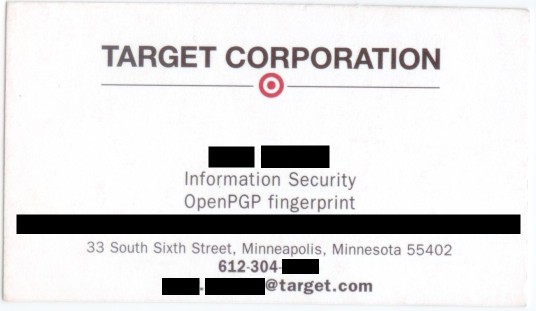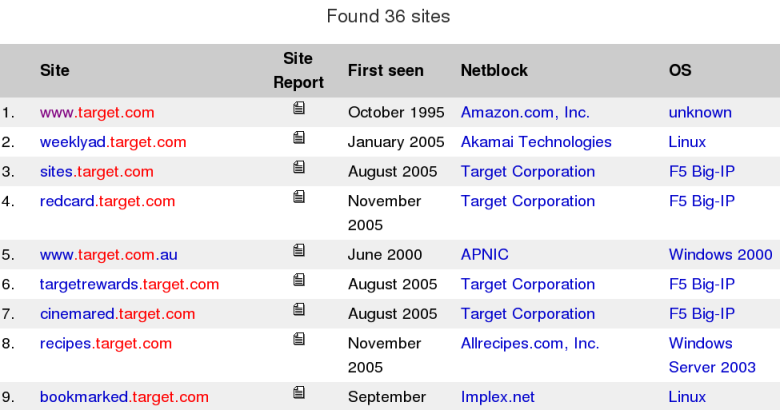Finding an Organization's IP Addresses
Nmap automates many aspects of network scanning, but you still
must tell it which networks to scan. I suppose you could specify
-iR and hope Nmap hits your target company randomly,
or you could try the brute force method of specifying 0.0.0.0/0 to scan the whole
Internet. But either of those options could take months or years, and
possibly get you into trouble. So it is important to carefully
research target netblocks before scanning them. Even if you are
conducting a legitimate
penetration test
and the client gave you a
list of their netblocks, it is important to double check them. Clients sometimes have out-of-date records or simply write them down wrong.
An authorization letter signed by your client won't help if you
accidentally break into the wrong company.
In many cases, you start with only a company's domain name. This section demonstrates a few of the most common and effective ways to turn that into a list of netblocks owned, operated by, or affiliated with the target company. Typical Linux command-line utilities are demonstrated, but similar tools are available for other platforms.
At the ShmooCon conference in 2006, a fellow came up to me and
complained that Nmap documentation specified many example ways to
scan
target.com.
He noted that ICANN had reserved the domain name
example.com
for this
purpose, and pressured me to revise the man page accordingly. While
he was technically right, it was a strange thing to obsess about. His
motivation became clear when he handed me his business card:

Apparently, many Nmap users copied examples straight from the man page and ran them without changing the target specifier. So target.com was flooded with scans and corresponding IDS alerts. In honor of that incident, the goal of this section is to determine IP ranges assigned to and used by Target Corporation.
DNS Tricks
The primary purpose of DNS is to resolve domain names into IP addresses, so it is a logical place to start. In Example 3.1, I use the Linux host command to query some common DNS record types.
>host -t ns target.comtarget.com name server ns4.target.com. target.com name server ns3.target.com. target.com name server ns1-auth.sprintlink.net. target.com name server ns2-auth.sprintlink.net. target.com name server ns3-auth.sprintlink.net. >host -t a target.comtarget.com has address 161.225.130.163 target.com has address 161.225.136.0 >host -t aaaa target.comtarget.com has no AAAA record >host -t mx target.comtarget.com mail is handled by 50 smtp02.target.com. target.com mail is handled by 5 smtp01.target.com. >host -t soa target.comtarget.com has SOA record extdns02.target.com. hostmaster.target.com.
Next I resolve the IP addresses for the hostnames above (using
host again) and I try a few common subdomain names such
as www.target.com and
ftp.target.com.
Starting with names like ns3.target.com and smtp01.target.com, I try changing the digits to find new machines.
All of this leaves me with the following target.com names and
addresses:
| Hostname | IP Addresses |
|---|---|
| ns3.target.com | 161.225.130.130 |
| ns4.target.com | 161.225.136.136 |
| ns5.target.com | 161.225.130.150 |
| target.com | 161.225.136.0, 161.225.130.163 |
| smtp01.target.com | 161.225.140.120 |
| smtp02.target.com | 198.70.53.234, 198.70.53.235 |
| extdns02.target.com | 172.17.14.69 |
| www.target.com | 207.171.166.49 |
While a substantial hostname list can be generated in this
manner, the mother lode of hostnames comes from a
zone transfer.
Most DNS servers now reject zone transfer requests, but it is worth
a try because many still allow it. Be sure to try every DNS server you
have found through domain NS records and port scanning corporate IP ranges.
So far we have found seven Target nameservers: ns3.target.com,
ns4.target.com, ns5.target.com, ns1-auth.sprintlink.net,
ns2-auth.sprintlink.net, ns3-auth.sprintlink.net, and
extdns02.target.com. Unfortunately, all of those servers either
refused the transfer or did not support the TCP DNS connections
required for a zone
transfer. Example 3.2 shows a failed
target.com zone transfer attempt using the common dig (domain
information groper) tool[9], followed by a successful one against an
unrelated organization (cpsr.org).
>dig @ns2-auth.sprintlink.net -t AXFR target.com; <<>> DiG 9.5.0b3 <<>> @ns2-auth.sprintlink.net -t AXFR target.com ; Transfer failed. >dig @ns2.eppi.com -t AXFR cpsr.org; <<>> DiG 9.5.0b1 <<>> @ns2.eppi.com -t AXFR cpsr.org cpsr.org 10800 IN SOA ns1.findpage.com. root.cpsr.org. cpsr.org. 10800 IN NS ns.stimpy.net. cpsr.org. 10800 IN NS ns1.findpage.com. cpsr.org. 10800 IN NS ns2.eppi.com. cpsr.org. 10800 IN A 208.96.55.202 cpsr.org. 10800 IN MX 0 smtp.electricembers.net. diac.cpsr.org. 10800 IN A 64.147.163.10 groups.cpsr.org. 10800 IN NS ns1.electricembers.net. localhost.cpsr.org. 10800 IN A 127.0.0.1 mail.cpsr.org. 10800 IN A 209.209.81.73 peru.cpsr.org. 10800 IN A 208.96.55.202 www.peru.cpsr.org. 10800 IN A 208.96.55.202 [...]
A common mistake when gathering forward DNS results like these
is assuming that all systems found under a domain name must be part of
that organization's network and safe to scan. In fact, nothing
prevents an organization from adding records pointing anywhere on the
Internet. This is commonly done to outsource services to third
parties while keeping the source domain name for branding. For
example, www.target.com resolves to 207.171.166.49. Is this part of
Target's network, or is it managed by a third party we might not want
to scan? Three quick and easy tests are
DNS reverse-resolution,
traceroute, and whois against the relevant IP address registry. The
first two steps can be done by Nmap, while the Linux whois command
works well for the third. These tests
against target.com are shown in
Example 3.3 and
Example 3.4.
# nmap -Pn -T4 --traceroute www.target.com
Starting Nmap ( https://nmap.org )
Nmap scan report for 166-49.amazon.com (207.171.166.49)
Not shown: 998 filtered ports
PORT STATE SERVICE
80/tcp open http
443/tcp open https
TRACEROUTE (using port 80/tcp)
HOP RTT ADDRESS
[cut]
9 84.94 ae-2.ebr4.NewYork1.Level3.net (4.69.135.186)
10 87.91 ae-3.ebr4.Washington1.Level3.net (4.69.132.93)
11 94.80 ae-94-94.csw4.Washington1.Level3.net (4.69.134.190)
12 86.40 ae-21-69.car1.Washington3.Level3.net (4.68.17.7)
13 185.10 AMAZONCOM.car1.Washington3.Level3.net (4.71.204.18)
14 84.70 72.21.209.38
15 85.73 72.21.193.37
16 85.68 166-49.amazon.com (207.171.166.49)
Nmap done: 1 IP address (1 host up) scanned in 20.57 seconds
In Example 3.3, the reverse DNS (two places) and interesting traceroute results are bolded. The Amazon.com domain name makes it highly likely that the web site is run by Amazon rather than Target itself. Then the whois results showing “Amazon.com, Inc.” as the IP space owner removes all doubt. The web site is Target branded, but displays “Powered by Amazon.com” at the bottom. If we were hired by Target to test their security, we would need separate permission from Amazon to touch this address space.
Web databases can also be used to find hostnames under a given
domain. For example,
Netcraft
has a web site DNS search feature at
http://searchdns.netcraft.com/?host.
Typing .target.com in to the form brings 36 results, as shown in
Figure 3.2. Their
handy table shows the netblock owner too, which catches cases such as
Amazon running www.target.com. We already knew about some of the
discovered hosts, but we would have been unlikely to guess names such
as sendasmoochie.target.com.

Google can also be used for this purpose with queries such as site:target.com.
Whois Queries Against IP Registries
After a set of initial “seed” IPs are discovered, they must be researched to ensure they belong to the company you expect and to determine what netblocks they are part of. A small company might have a tiny allocation of 1–16 IP addresses, while larger corporations often have thousands. This information is kept in regional databases, such as ARIN (American Registry for Internet Numbers) for North America and RIPE for Europe and the Middle East. Modern whois tools take an IP address and automatically query the appropriate registry.
Small and mid-sized companies normally don't have IP space allocated by the likes of ARIN. Instead, they are delegated netblocks from their ISPs. Sometimes you get this ISP information from IP queries. This generally leaves you with a big netblock and you don't know which portion of it is allocated to your target. Fortunately, many ISPs now subdelegate customer ranges using Shared Whois (SWIP) or Referral Whois (RWhois). If the ISP has done this, you learn the customer's exact netblock size.
One of the IP addresses previously discovered for target.com
was 161.225.130.163. Example 3.5
demonstrates a whois query (automatically directed against ARIN) to
determine the owner and IP allocation information for this IP.
> whois 161.225.130.163
[Querying whois.arin.net]
[whois.arin.net]
OrgName: Target Corporation
OrgID: TARGET-14
Address: 1000 Nicollet TPS 3165
City: Minneapolis
StateProv: MN
PostalCode: 55403
Country: US
NetRange: 161.225.0.0 - 161.225.255.255
CIDR: 161.225.0.0/16
NetName: TARGETNET
NetHandle: NET-161-225-0-0-1
Parent: NET-161-0-0-0-0
NetType: Direct Assignment
NameServer: NS3.TARGET.COM
NameServer: NS4.TARGET.COM
Comment:
RegDate: 1993-03-04
Updated: 2005-11-02
OrgTechHandle: DOMAI45-ARIN
OrgTechName: Domainnames admin
OrgTechPhone: +1-612-696-2525
OrgTechEmail: Domainnames.admin@target.com
Not surprisingly, Target owns a huge Class B netblock, covering all 65,536 IPs from 161.225.0.0 through 161.225.255.255. Since the OrgName is Target, this isn't a case where we are seeing results from their ISP.
The next step is to similarly look up all previously discovered
IPs which don't fall within this range. Then you can begin with more
advanced queries. The command whois -h whois.arin.net
\? gives the ARIN query syntax. It would be nice if you
could search for all netblocks matching a given address, OrgID, or
OrgTechEmail, but IP registries generally don't allow that. However,
many other helpful queries are allowed. For example, whois
-h whois.arin.net @target.com shows all the ARIN contacts
with email addresses at target.com. The query whois -h
whois.arin.net "n target*" shows all the netblock handles
starting with target. It is not case sensitive.
Similarly, whois -h whois.arin.net "o target*"
shows all of the organizational names starting
with target. You can look up the address, phone
number, and contact email associated with each entry to determine
whether they are part of the company you wish to scan. Often they are
3rd parties who happen to have a similar name.
Internet Routing Information
The core routing protocol of the Internet is the Border Gateway
Protocol (BGP).
When scanning mid-sized and large organizations, BGP
routing tables can help you find their IP subnets all over the world.
For example, suppose you want to scan IP addresses belonging to
Microsoft Corporation. A DNS lookup
for microsoft.com provides the IP
address 207.46.196.115. A whois query as discussed
in the previous section shows that the whole 207.46.0.0/16 block
belongs to Microsoft at their appropriate
“One Microsoft Way” address in Redmond. That provides
65,536 IP addresses to scan, but BGP tables expose many more.
Entities such as Microsoft are assigned autonomous system (AS)
numbers
for routing purposes. A handy tool for determining the AS
number advertised for a given IP address is available at
http://asn.cymru.com/.
Typing 207.46.0.0 into this form provides
Microsoft's AS number 8075. Next, I want to find all of the IP
prefixes which route to this AS. A handy tool for doing so is
available at http://www.robtex.com/as/. Typing
in AS8075 and hitting Go on
that page leads to a summary screen showing 42 prefixes found. Those prefixes
represent 339,456 IP addresses and can be enumerated by clicking the BGP tab.
While obtaining BGP information from canned web forms such as
these is convenient, obtaining routing data from actual routers is
more fun and may allow more powerful custom queries. Several
organizations provide such a service. For an example, telnet
to route-views.routeviews.org or visit
http://routeviews.org. Of course these services
provide read-only access to the data. If you need to manipulate
global routing tables as part of a diabolical plan to take over the
Internet, that is beyond the scope of this book.
[9] Nmap's dns-zone-transfer NSE script could have been used instead (see Chapter 9, Nmap Scripting Engine).
